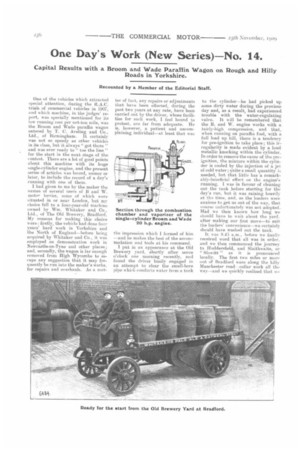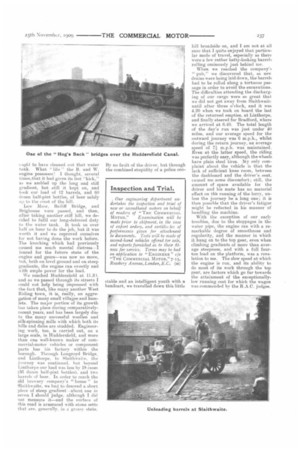One Day' s Work (New Series) No. 14.
Page 4

Page 5

If you've noticed an error in this article please click here to report it so we can fix it.
Capital Results with a Broom and Wade Paraffin Wagon on Rough and Hilly Roads in Yorkshire.
Recounted by a Member of the Editorial Staff.
One of the vehicles which attracted special attention, during the
trials of commercial vehicles in 1907, and which machine, in the judges' report, was specially mentioned for its low running cost per net-ton mile, was the Broom and Wade paraffin wagon entered by T. C. Aveling and Co., Ltd., of Birmingham. it certainly WEIS not so speedy as other vehicles in its class, but it always " got there " and was ever ready to " toe the line " for the start in the next stage of the contest. There are a lot of good points about this machine with its huge single-cylinder engine, and the present series of articles was bound, sooner or later, to include the record of a day's running with one of them.
I had given to me by the maker the names of several users of B and W. motoe lorries, some of which were situated in or near London but my choice fell to a four-year-old machine owned by Wm. Whitaker and Co., Ltd., of The Old Brewery, Bradford. My reasons for making this choice were: firstly, the vehicle had done four years' hard work in Yorkshire and the North of England—before being acquired by Whitaker and Co., it was employed on demonstration work in Newcastle-on-Tyne and other places; and, secondly, the wagon is far enough removed from High Wycombe to escape any suggestion that it may frequently be run into the maker's works, for repairs and overhauls. As a mat
ter of fact, any repairs or adjustments that have been effected, during the past two years at any rate, have been carried out by the driver, whose facilities for such work, I feel bound to protest, are far from adequate. He is, however, a patient and uncomplaining individual—at least that was the impression which I formed of him —and he makes the best of the accommodation and tools at his command.
I put in an appearance at the Old Brewery yard, shortly after seven o'clock one morning recently, and found the driver busily engaged in an attempt to clear the small-bore pipe which crindnets water from a tank
to the cylinder—he had picked up. some dirty water during the previous day and, as a result, had experienced. trouble with the water-regulating valve. It will be remembered that the B. and W. engine works with a fairly-high compression, and that, when running on paraffin fuel, with a full load up hill, there is a tendency for pre-ignition to take place; this irregularity is made evident by a loud metallic knocking within the cylinder. In order to remove the cause of the preignition, the mixture within the cylinder is cooled by the injection of a jet of cold water ; quite a small quantity is needed, but that little has a remarkably-beneficial effect on the engine's running. I was in favour of cleaning out the tank ,before starting for the day's run, but it was raining heavily at the time, and, as the loaders were anxious to get us out of the way, that course unfortunately was not adopted. Had we then known how long we should have to wait about the yard. after making our first move—to suit the loaders' convenience—we certainly should have washed out the tank.
It was S.45 a.m., before we finally received word that all was in order, and we then commenced the journey to Huddersfield, and Slaithwaite, or " Slowitt " as it is pronounced locally. The first two miles or more out of Bradford were along the hilly Manchester road--collar work all the way—and we quickly realized that we
■ ,11.91d to have cleaned out that water tank. What " life" the B. and W. engine possesses! I thought, several times,that it had given its last "kick," as we ambled up the long and still gradient, but still it kept on, and took our load of 12 barrels, and 60 dozen half-pint bottles, of beer safely up to the crest of the hill.
Low Mom-, Bailiff Bridge, and Brighouse were passed, and then, after taking another stiff hill, we decided to fulfil our long-deferred duty to the water tank. It took us over half an hour to do the job, but it was worth it and we reproved ourselves for not having done the work before. The knocking which bad previously caused me much mental distress—i feared for the future state of the engine and gears—was now no more, but, both on level ground and on steep gradients, the engine ran sweetly and with ample power for the load.
We reached Huddersfield at 11.31 and as we passed through its streets I could not help being impressed with the fact that, like many another West Riding town, it is, really, an aggregation of many small villages and hamlets. The major portion of its growth Juts taken place during comparativelyrecent years, and has been largely due to the. many successful woollen and silk-spinning mills with which both its hills and dales are studded. Engineering work, too, is carried out, on a large scale, in Huddersfield, and more than one well-known maker of commercial-motor vehicles or component parts has his factory within the borough. Through Longroyd Bridge, and Linthorpe, to Slaithwaite, the journey was continued. but beyond Linthorpe our load was less by 16 cases (36 dozen half-pint bottles), and two barrels of beer. In order to reach the old brewery company's " house " in Slaithwaite, we had to descend a short piece of steep gradient -about one in seven I should judge, although I did not. measure it—and the surface of this road is armoured with stone setts that are, generally, in a greasy state. By no fault of the driver, but through the combined stupidity of a police con
stable and an intelligent youth with a handcart, we travelled down this little hill broadside on, and I am not at all sure that I quite enjoyed that particular mode of travel, especially as there were a few rather hefty-looking barrels rolling ominously just behind me. When we reached the company's
we discovered that, as new drains were being laid down, the barrels had to be rolled along a tortuous passage in order to avoid the excavations. The difficulties attending the discharging of our cargo were so great that we did not get away from Slaithwait,, until after three o'clock, and it was 4.20 when we took on hoard the last of the returned empties, at Linthorpe, and finally steered for Bradford, where we arrived at 6.40_ The total length of the (lay's run was just under 40 miles, and our average speed for the outward journey was 6 m.p.h., whilst during the return journey, an average speed of V. m.p.h. was maintained. Even at the latter speed, the riding was perfectly easy, although the wheels have plain steel tires. Dity only complaint about the vehicle is that the lack of sufficient knee room, between the dashboard and the driver's seat, caused me some discomfort; still, the amount of space available for the driver and his mate has no material effect on tlit running of the lorry, unless the journey be a long one; it is then possible that the driver's fatigue might be reflected in his manner of handling the machine. With the exception of our early troubles, due to the stoppages in the water pipe, the engine ran with a remarkable degree of smoothness and regularity, and the manner in which it hung on to the top gear, even when climbing gradients of more than average steepness, and with a full fourton load on the platform, was a revelation to me. The slow speed at which the engine is run, and its ability to do most of its work through the top gear, are factors which go far towards the attainment of the exceptionallylow running cost for which the wagon was commended by the R.A.C. judges.




















